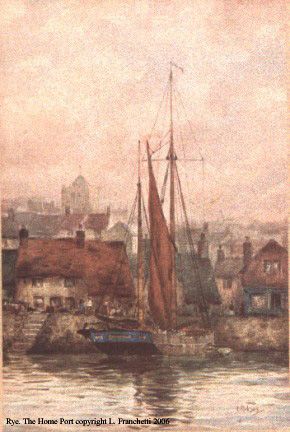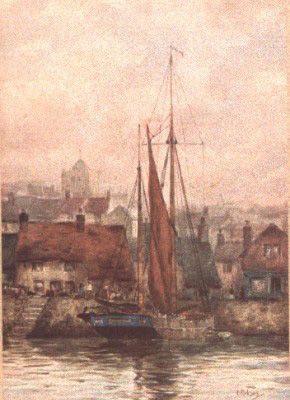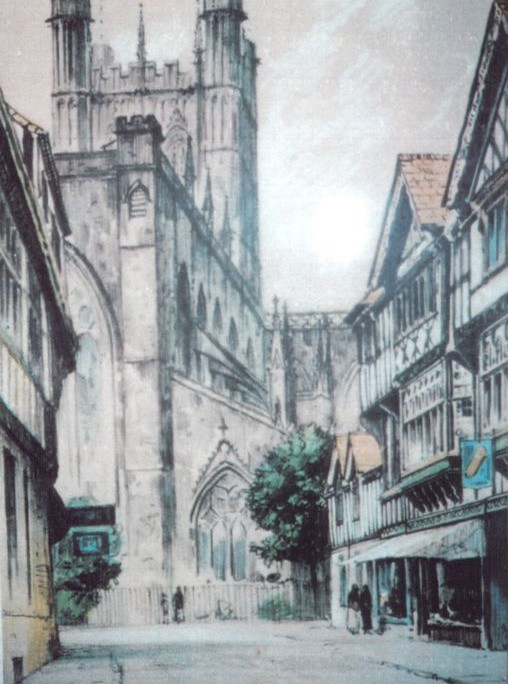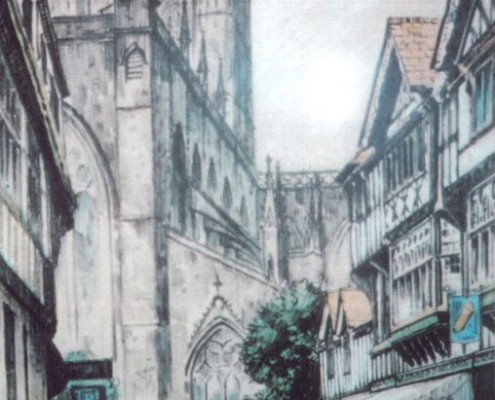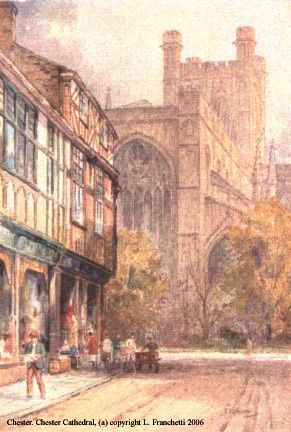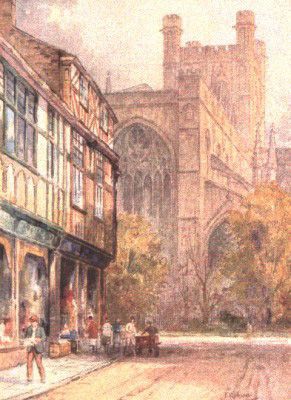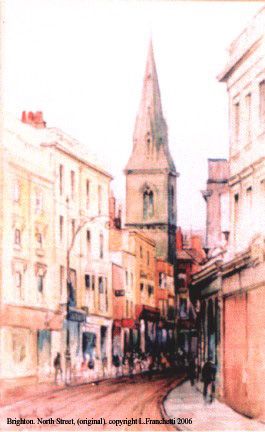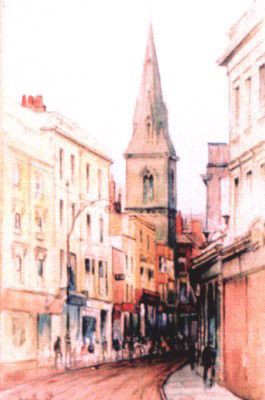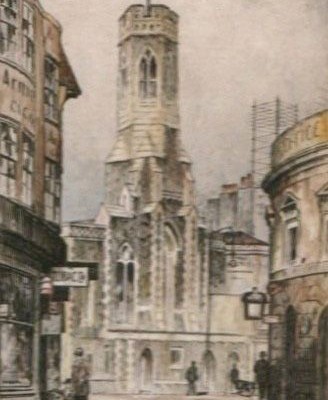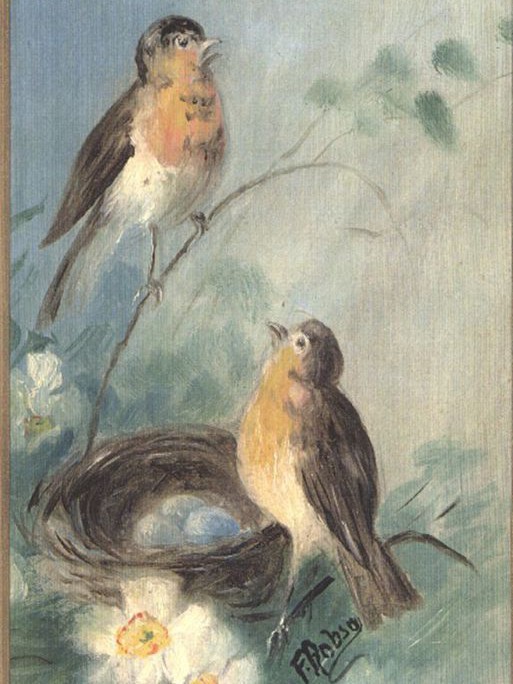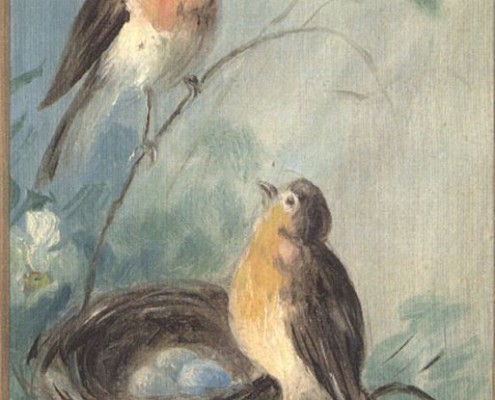In 2000 I printed the 2nd edition of the book “An Artist Remembered” having got new original artworks and prints. I also added additional information to the book about him
Below are a few examples from the book. Should you be interested in buying the book. The book costs £8.50 inc. delivery for UK and £16.00 inc. delivery to post Air Mail to rest of the world.
Purchase book with Paypal:
Preface
Featherstone Robson represents the type of artist that flourished in the early part of the last century before the advent of high-speed colour photography. He was one of a group of artists very much in demand to illustrate to people who were interested in their native country Britain, just what beauty existed around it.
He commuted between the worlds of fine art, painting pictures that he sold to the drawing boards of the great commercial printers producing thousands of illustrations of the beauty of Britain.
He was in a way, painting for posterity recording Britain. Thanks to Robson and others like him who have captured images of churches, cathedrals, farms, picturesque thatched cottages, coaching inns, water mills and windmills, seascapes and rural landscapes, we have a social history of a Britain that has almost disappeared.
Featherstone Robson died in 1936 and little is known about him. The main aim of this book is to gain recognition for his name in the art world and to give some insight into his life to the many collectors of his work.
My introduction to this artist began in the late 1960’s. My wife and I were living in Sheffield and had decided to move to Northumberland where my wife was born. Before we left, my grandmother gave me two prints of York, bought for her in 1922 by my grandfather that I had always admired. They were in fancy gilt frames and they bore the signature ‘F. Robson’. Many years later, I was browsing in an antique shop when I came across another such print which I bought and from then on, I found myself actively looking for them on my travels.
I tried to find out more about the artist but could find little information then I came across a book by Marshall Hall called ‘The Artists of Northumbria’ and I found him mentioned there. I discovered that he was born in Hexham, Northumberland and that not much was known about him. This set me off trying to track him down which proved to be quite difficult as he rarely stayed in one place for any length of time.
When I began the project, I sent letters to most of the newspapers in the country asking for information about him and I was inundated with replies from people who have prints of his work and wanted to find out more about him. I eventually managed to locate two of his nephews and also his daughter Mrs Jeanne Viney, who gave me the best account of her father that I could possibly wish for.
During my research for this book, I have visited many of the places where the artist lived, including Toronto where he died, and I have made contact with many keen collectors who have kindly sent me copies of their prints. This has enabled me to compile a photographic as well as written list of his known work.
Not many of his original paintings have surfaced except for the ones owned by family members, and it would appear that at this time he is better known for his prints than for his original works.
The information in this book is partly research from archives and newspapers and in the main, “spoken history” based on the recollections of his late daughter and also his nephew and namesake, the Reverend Featherstone Robson. I am indebted to Peter Viney, for the many hours he spent talking with his mother and capturing her recollections on tape. I would like to thank them for their invaluable help.
Leonard Franchetti. – 2006
The Early Years
At the age of 13, Featherstone was apprenticed to William English, a Harness; Leather & Rubber Manufacturer based at Tyne Works, 27–29 Fowler Street, South Shields. The firm moved from that address in the early 1900’s to 9, Albion Terrace, part of Fowler Street, where the son of William English ran the firm from April 18, 1902, after the death of his father.
A year into his apprenticeship Featherstone began to study at the South Shields School of Art. In 1892, George Horton (1) himself a native of the North East who was to find fame as a watercolorist and etcher, opened a studio in Sidney Street, North Shields. He placed an advertisement in the Shields Gazette offering “Lessons in Water-Colour Drawing in Marine or River Subjects and in Landscapes” and Featherstone became one of his pupils. In 1896 Horton, who by then was living at 61 Winchester Street, South Shields made his first sketching trip to Holland.
It would appear that at some point Featherstone went with Horton on one of his trips as a number of prints depicting scenes from Holland have surfaced. Close inspection reveals that there are similarities to George Horton’s work in Robson’s early style.
Fig 6
Robson and Horton remained good friends and Robson’s daughter remembers Horton often staying with them when they were living in Wrothom Road, Barnet.
He served out his apprenticeship as a harness maker but his heart was not in it and he gave it up to concentrate on art.
Years later, Featherstone’s daughter Jeanne described her father as having “itchy feet”, which, given his many travels, was something of an understatement.
At the age of 17 the budding young artist started his travels and went to London.
Once in London, Featherstone set about getting a job in the printing and engraving business, he eventually became well known in the field of Mechanical Engraving and was to hold positions of responsibility with many printing firms.
He worked for The Strand Engraving Company; Waterlow & Sons and also for Carl Hentschel (4).
Robson’s nephew, the Reverend F. Robson of Abingdon, remembers as a 15 year old boy being on a bus with his mother and as they passed by 182, Fleet Street, London, she told him that his Uncle Featherstone had once lodged there in a garret when he was a young man. This could indeed be correct because this was the premises of Carl Hentschel and it is a recorded fact that some of his workers did live on the premises. Featherstone Robson painted St Dunstans, Fleet Street from the West and 182 Fleet Street is one of the buildings in the painting.
Photographs & Prints
Fig 1. Front Cover: Self-portrait of Featherstone Robson, 1902.
Fig 2. The author Leonard Franchetti.
Fig 3. Walter and Jane Ann Robson.
Fig 4. F. Robson’s grandson, Peter Viney outside 2, Bell Terrace, Tyne Green, Hexham.
Fig 5. The Robson family, taken about 1905. From left to right.
Back row: Edith, Featherstone, John, Maud.
Front row: Walter Junior, Walter Senior, Roland, Jane Ann, Arnold.
Fig 6. St Paul’s, London. Print.
Fig 7. Along the River Maas, Holland. Print.
Fig 8. The Monument, London. Print.
Fig 9. Westminster Abbey, London. Print.
Fig 10. Newly wed, Featherstone and Maud, on the steps of the Church; Vancouver, 1911.
Fig 11. Robson and brother-in-law Jack Woolgar in fancy dress outfits. Vancouver, 1911.
Fig 12. The Log Cabin. First home of Featherstone and Maud Robson. Vancouver, 1911.
Fig 13. I.P.E.U. Banquet, Vancouver B.C. January 14th, 1911.
Fig 14. The Mr. and Mrs. Robson with daughter Jeanne returning to England by boat, 1914.
Fig 15. Portait of Jeanne Robson aged 3 years. Painted from a photograph.
Fig 16. The Three Spires, Coventry. Print.
Fig 17. Near Petersfield, Sheet Mill. Print.
Fig 18. Elvet Bridge and Cathedral, Durham. Print.
Fig 19. The River Colne, near Watford, Exhibited 1923 at the R.A London.
Fig 20. Warwick Castle, from the Road Bridge. Print.
Fig 21. The Bridge at Abingdon. Print.
Fig 22. F.Robson with portrait of his daughter Jeanne, painted for her 21st. birthday, 1934.
Fig 23. F. Robson with portrait of his wife Maud in Toronto, Canada, 1934.
Fig 24. F. Robson’s grave marker at Mount Pleasant Cemetery, Toronto.
Fig 25. Featherstone Robson.
Fig 26. Maud, Jeanne and Mrs. Jane Robson in South Shields.
Fig 27. Along the Thames. Print.
Fig 28. The West Pier and Beach, Brighton. Print.
Fig 29. The City Cross, Winchester. R.Featherstone. Print.
Fig 30. Whittle Mill, Northumberland. Pen and ink drawing.
Fig 31. The Quayside Shop. Pen and ink drawing.
Fig 32. The Clock Tower, St. Albans. Pen and ink drawing.
Fig 33. St. Brides Church Spires, London. Pen and ink drawing.
Fig 34. Print. ‘Guys Cliffe Mill, Warwick’.
Fig 35. The Old Mill, Jesmond Dene. Print.
Fig 36. Ambleside. Print.
Fig 37. With the wind. Print.
Fig 38. Watercolour. ‘ Nootka Native American Indians. Vancouver Island. B.C ‘
Fig 39. Sterling Castle. Print.
Fig 40. Queen Victoria Monument , Birmingham. Print.
Fig 41. Watercolour . ‘Amazon’
Fig 42. Watercolour . ‘The Wreck, Frenchmans Bay, South Shields.
Fig 43. Watercolour. ‘The Low Lights, North Shields.’
Fig 44. Watercolour. ‘The peaceful stream’
Fig 45. Watercolour. ‘ The peaceful river’
Fig.46. Watercolour. ‘ Among the Canadian Rockies’. 1913.
Fig 47. Back Cover. Sandhills, Newcastle on Tyne. C Manning. Print.
1905 Exhibits 2 paintings at the Laing Art Gallery, Newcastle.
1906 Sets off for London again. Becomes a pupil of Brangwyn. Goes on painting trip to Europe.
1909 Robson’s father dies and he returns to South Shields.
1910 Went to Vancouver, Canada with his fiancé Maud, his sister Edith and her fiancé Jack Woolgar and her brother Walter who was to be best man.
1911 Featherstone and Maud get married in Vancouver, Canada.
1912 Featherstone and his wife spend some time in Seattle, Chicago and New York. He exhibits in these places during his stay.
1913 The Robsons return to South Shields for the birth of their child. Daughter Jeanne is born 19th July.
1914 His sister Edith dies shortly after giving birth and Jack Woolgar returns to South Shields, England. Featherstone and his family are living in Chicago and then decide to return home to England.

